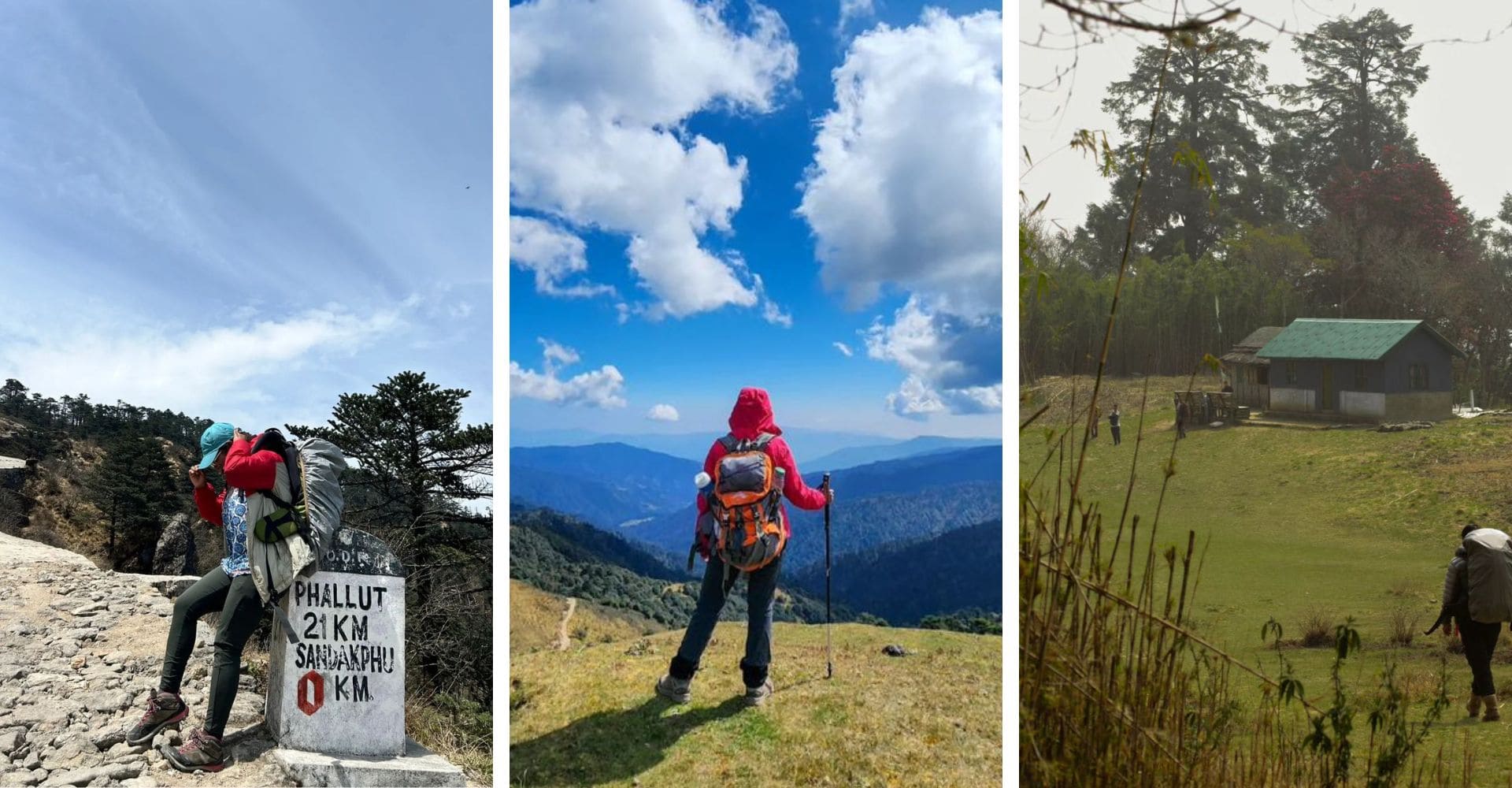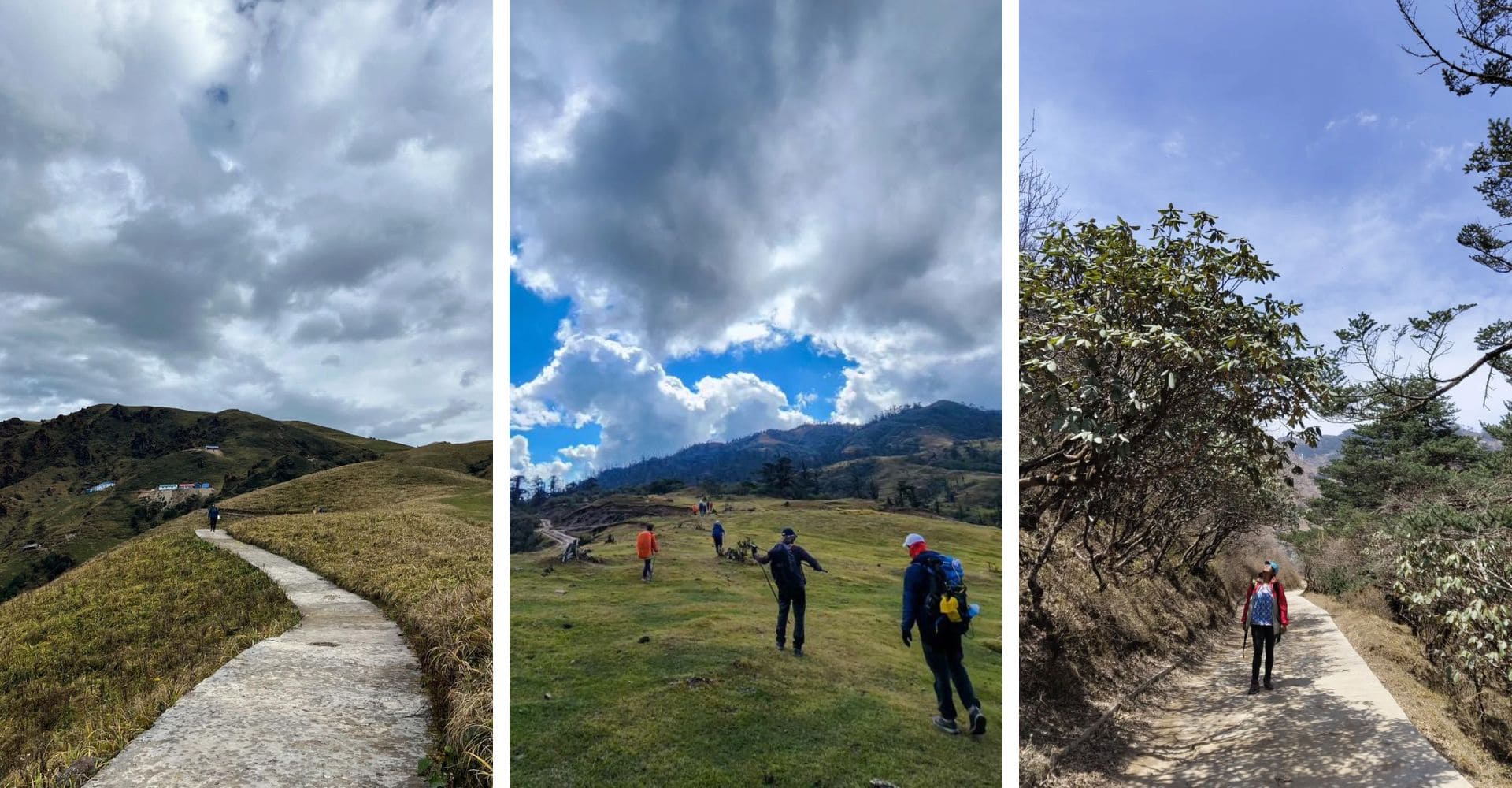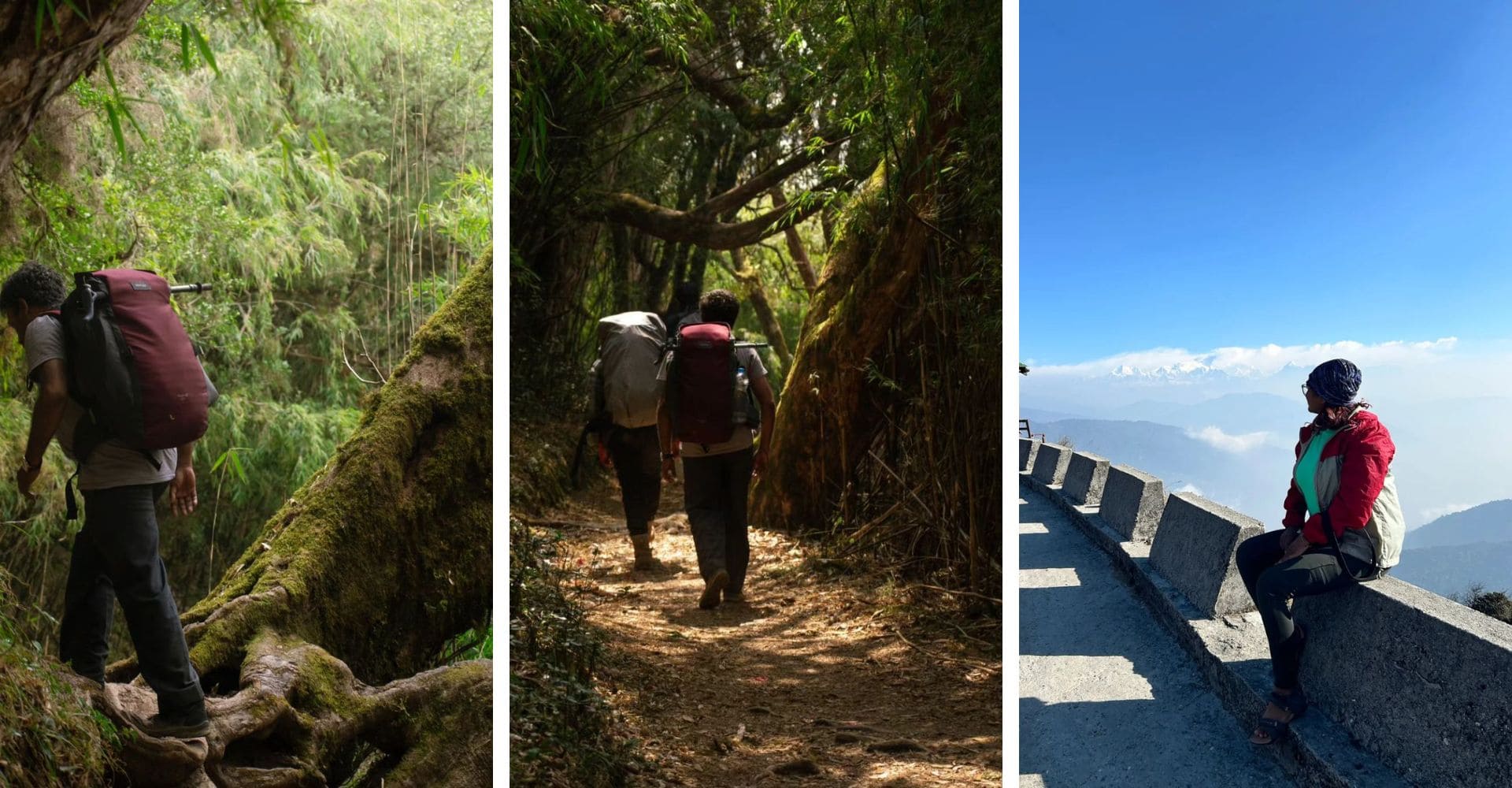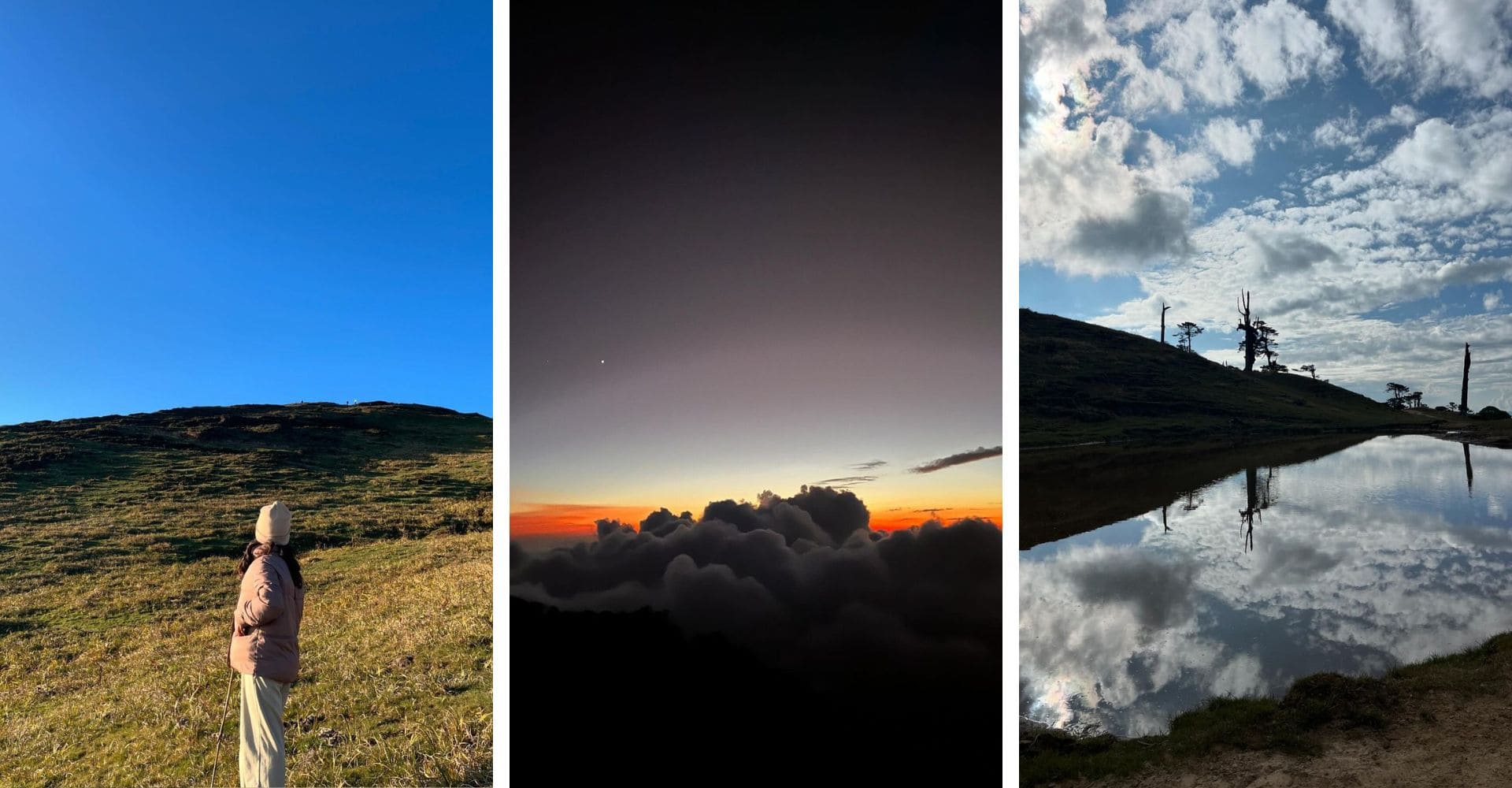



Tour Highlights
Inclusion/Exclusion
Package Cost Includes
Package Cost Excludes
Jan 2025: 1, 2, 3, 4
Day 1: NJP/Bagdogra to Kopidana
Distance covered: Approximately 80 km by road
Time taken: 5-6 hours
Elevation gain: 100 m to 1,950 m
Day 2: Kopidana to Tumling
Distance covered: 11 km
Time taken: 5-6 hours
Elevation gain: 1,950 m to 2,970 m
Day 3: Tumling to Kalapokhri
Distance covered: 13 km
Time taken: 6-7 hours
Elevation gained: 2,970 m to 3,186 m
Day 4: Kalapokhri to Sandakphu
Distance covered: 6 km
Time taken: 3-4 hours
Elevation gain: 3,186 m to 3,636 m
Day 5: Sandakphu to Sepi
Distance covered: 16 km
Time taken: 7-8 hours
Elevation loss: 3,636 m to 1,830 m
Day 6: Sepi to NJP/Bagdogra
Distance covered: Approximately 80 km by road
Time taken: 5-6 hours
Elevation loss: From 1,830 m to 100 m
Sandakphu Trek Overview
The Sandakphu Trek is an extraordinary trek through the Singalila Ridge, located on the border of India and Nepal. This trek is one of the most comprehensive experiences of the Himalayas, offering breathtaking views of some of the worlds highest peaks, including Kanchenjunga, Everest, Lhotse, and Makalu. At its highest point, Sandakphu, located at an altitude of 11,929 feet, you will get to see a view that is nothing short of awe-inspiring in all 360 degrees around you.
But this trek is not just about high-altitude views. It is also a journey through rich cultural landscapes, passing through quaint villages where you will experience the warmth of local hospitality. As you walk along the ridge, you will find yourself surrounded by the vibrant flora of the Singalila National Park, home to the famous rhododendron forests, and if you are lucky, you may even spot the elusive red panda. Whether you are an avid trekker or a nature enthusiast, the Sandakphu trek offers an experience that is both challenging and extremely rewarding.
Historical and Cultural Significance
The history of the Sandakphu trek dates back to the British colonial era. During the 19th century, British explorers and botanists discovered the beauty of the Singalila Ridge and documented its rich biodiversity. The Sandakphu trek became a popular route for those seeking the thrill of exploring unknown regions and enjoying the Himalayan scenery. The trek has since evolved into a classic Himalayan adventure, attracting trekkers from all over the world.
Cultural Encounters and Rural Life
As you travel through the region, you will pass through several local villages on the Sandakphu trail, each of which offers a glimpse into the traditional lifestyle of the communities living in this remote part of the Himalayas. Villages such as Tumling, Kalapokhari, and Sepi are home to ethnic groups such as the Sherpa, Lepcha, and Rai. These communities have preserved their cultural heritage for centuries, and trekkers get the opportunity to experience their customs, traditions, and hospitality first-hand.
• Tumling Village: Located on the Indo-Nepal border, Tumling offers a unique opportunity to experience life in a traditional Nepali village. The homestays in the Sandakphu villages are warm and welcoming, providing a comfortable resting place for trekkers.
• Kalapokhari Village: Known for its sacred Black Lake, Kalapokhari Village is a spiritual stop on the trek. Surrounded by Buddhist prayer flags, the lake is considered sacred by the locals and adds a spiritual dimension to the trip.
• Sepi Village: The trek culminates in Sepi, a charming village where trekkers can interact with locals and gain in-depth insight into the villagers daily lives.
Spiritual and Religious Elements
The Sherpa culture in Sandakphu is deeply intertwined with Buddhism, and this is evident in the many stupas, prayer flags, and monasteries scattered along the trail. The trek passes through several sacred sites, including the iconic Kalapokhri Lake. The spirituality of the region is evident, and many trekkers find the experience contemplative.
What Makes the Sandakphu Trek Special?
The Sleeping Buddha Formation
One of the most iconic landmarks on this trek is the Kanchenjunga Range, often referred to as the “Sleeping Buddha” because the peaks resemble a reclining Buddha. This view is particularly prominent from Sandakphu, where the mountains appear like a serene, sleeping deity guarding the horizon. This formation is a visual highlight that sets the Sandakphu trek apart from other Himalayan treks.
India-Nepal Border Crossing
This trek offers a unique experience of walking on the border between India and Nepal. The trek to Sandakphu and often enters Nepal, offering trekkers the unique experience of crossing two countries on foot. The seamless transition between the two countries, marked only by a simple border pillar, adds a special international flavor to the trip.
Diverse Ecosystems and Changing Landscapes
This trek covers a variety of ecosystems, from temperate forests at lower altitudes to alpine meadows and barren high-altitude terrains near Sandakphu. The changing landscapes make the trek engaging and visually stimulating. The diversity of flora and fauna, from dense rhododendron forests to rare endemic species in the Sandakphu trek, makes this trek a constantly evolving adventure.
Cultural Immersion and Local Handicrafts
Along the route, trekkers have the opportunity to immerse themselves in the local culture. The villages you pass through offer a glimpse into the traditional lifestyle of the inhabitants. You can also buy local handicrafts in the Sandakphu trek, which are handmade by local artisans, supporting sustainable tourism in the region.
Best Time to Sandakphu Trek
The best time for the Sandakphu trek depends on the type of experience you want, with spring (March-May) and autumn (October-November) being the most popular seasons.
Spring (March to May): During these months, you will find temperatures between 10°C and 15°C, with occasional rains making the path muddy. This season is perfect for enjoying the vibrant rhododendron blooms and lush surroundings. Bird watching is also ideal as the forests are full of life.
Autumn (October to November): The weather ranges from 8°C to 12°C during the day, and the nights are cool. This season is known for clear skies, offering spectacular views of the Sandakphu peak and breathtaking sunrises. However, be prepared for a steep and challenging slope from Sandakphu to Sepi.
Monsoon (June to September): Heavy rains during these months make the trail slippery and prone to landslides, and temperatures vary considerably depending on the altitude. The landscape becomes lush, but trekking is generally not recommended due to difficult conditions.
Winter (December to February): Winter brings extremely cold temperatures, snow-covered trails, and icy conditions. The trek becomes challenging and is only recommended for experienced trekkers. Despite the cold, the snow-covered landscape offers a serene and unique experience for those prepared for winter.
Level of Difficulty Sandakphu Trek
The Sandakphu Trek is classified as moderate in difficulty, making it suitable for both seasoned trekkers and fit beginners. A good fitness level is essential due to the significant altitude changes and the overall length of the trek.
Trail Conditions: The terrain varies, including well-defined paths, forested areas, rocky sections, and open meadows. The trek involves gradual ascents and descents, with steeper climbs on the third and fourth days, particularly when approaching Sandakphu. The forest sections, especially in Singalila National Park, can be challenging, becoming muddy and slippery after rain.
Altitude and Elevation Gains/Descents:
Seasonal Challenges:
Physical Fitness Requirements: Trekkers should have good cardiovascular endurance and leg strength. Regular aerobic and leg-strengthening exercises are recommended. Proper acclimatization is crucial to avoid altitude sickness, and trekkers should be aware of its symptoms and take necessary precautions.
How to Reach Sandakphu Trek
Embarking on the Sandakphu Trek requires careful planning to ensure a smooth journey from your starting point to the treks conclusion. Heres a detailed guide based on the 6-day itinerary:
Arrival at NJP/Bagdogra
Pickup and Drop Services
Sandakphu Trek Itinerary
Day 1: NJP/Bagdogra to Kopidana
Distance covered: Approximately 80 km by road
Time taken: 5-6 hours
Elevation gain: 100 m to 1,950 m
Weather conditions: Day temperatures range from 15°C to 20°C, with a mild and comfortable climate.
As you begin your adventure, the excitement builds up during the scenic drive from NJP or Bagdogra to Kopidana. The 80 km journey takes around 5-6 hours, starting with serene views of lush green tea plantations and rolling hills. As you climb higher, the landscape changes, gradually revealing the majestic Himalayas. Arriving at Kopidana, a quaint village located at an altitude of 1,950 m, you will feel a change in culture with traditional Nepali houses. The mild temperature of 15°C to 20°C during the daytime creates a comfortable atmosphere for the trek ahead.
Day 2: Kopidana to Tumling
Distance covered: 11 km
Time taken: 5-6 hours
Elevation gain: 1,950 m to 2,970 m
Weather conditions: The temperature during the day ranges from 10°C to 15°C, and the conditions are cool and comfortable during the climb.
The trek from Kopidana to Tumling covers a distance of 11 km in 5-6 hours, taking you through a variety of landscapes. You will start amidst dense rhododendron forests and open grasslands, making the trekking experience easy. As you reach an altitude of 2,970 m, the temperature drops from 10°C to 15°C. Tumling, located on the Indo-Nepal border, is a charming village that offers a rich cultural experience. Staying in a traditional homestay, you will enjoy the warmth and hospitality of the local community.
Day 3: Tumling to Kalapokhri
Distance covered: 13 km
Time taken: 6-7 hours
Elevation gained: 2,970 m to 3,186 m
Weather conditions: Daytime temperatures range from 8°C to 12°C, and the breeze gets cooler as you climb higher.
The journey from Tumling to Kalapokhri is 13 km and takes 6-7 hours, gradually climbing to an altitude of 3,186 m. The air gets cooler as you climb higher, with daytime temperatures ranging from 8°C to 12°C. The route through Singalila National Park offers breathtaking views of the Kanchenjunga range and vibrant rhododendron forests. Kalapokhri, or "Black Lake", is a sacred and serene spot, surrounded by prayer flags. The tranquil lake and its spiritual ambiance provide an ideal place for contemplation and relaxation.
Day 4: Kalapokhri to Sandakphu
Distance covered: 6 km
Time taken: 3-4 hours
Elevation gain: 3,186 m to 3,636 m
Weather conditions: Daytime temperatures range from 5°C to 10°C, and it is cool and windy when you reach the highest point of the trek.
The trip to Sandakphu is one of the most satisfying days, as you climb to the highest point of the trek. The climb is steep, but the effort is worth it when you reach Sandakphu. Upon reaching, you get to see an incredible 360-degree view of the Himalayan range, including the peaks of Everest, Kanchenjunga, Lhotse, and Makalu. The sunset here is a picturesque sight, with the mountains glowing in orange and pink.
Day 5: Sandakphu to Sepi
Distance covered: 16 km
Time taken: 7-8 hours
Elevation loss: 3,636 m to 1,830 m
Weather conditions: Daytime temperatures range from 10°C to 18°C, and the trail descends gradually through different terrains.
The descent from Sandakphu to Sepi is long and can be stressful on the knees. The trail takes you through a variety of terrains from alpine meadows to dense forests, offering a different perspective of the landscapes you encounter on your way. The trek ends at Sepi, a beautiful village where you can interact with the locals and experience their way of life. This final cultural immersion is a fitting end to the trek, leaving you with lasting memories of the people and places you have met.
Day 6: Sepi to NJP/Bagdogra
Distance covered: Approximately 80 km by road
Time taken: 5-6 hours
Elevation loss: From 1,830 m to 100 m
Weather conditions: Daytime temperatures range from 15°C to 25°C, and the climate is comfortable and warm while descending.
The trek concludes with a drive back to NJP or Bagdogra. As you descend from the heights of the Himalayas, the journey gives you time to reflect on the unforgettable experiences of the past days, ranging from stunning mountain views to rich cultural encounters.Top of Form
Why Choose Our Sandakphu Trek Package?
Sandakphu Trek: Essentials
Trekking is undoubtedly one of the most thrilling adventures one can experience. With the breathtaking beauty of nature and the unparalleled charm of pristine mountain ranges, trekking stands out as a unique adventure worldwide. However, every great experience comes with its own set of responsibilities. Before embarking on a trek, there are certain important aspects to consider. Here a list of essential items and requirements to keep in mind for a successful trekking experience. Lets take a closer look at these trekking prerequisites.
Things You Can not Afford Missing On Trek
1. Backpack/RukSack
A high-quality backpack with sturdy, durable straps and a comfortable carrying design is essential for any trekking adventure. The more comfortable it is to carry, the more enjoyable your trek will be.
2. Trekking Shoes
Regular sports shoes can be problematic on a trek and may end up diminishing your experience. To navigate slippery patches and stream crossings safely, invest in a pair of trekking shoes with excellent grip. They will not only keep you steady but also significantly enhance your overall trekking experience.
Clothing
Choosing the right clothing is crucial for trekking, but there is no need to overpack for what-if scenarios. Stick to the essentials and carry only what you will typically need. Overpacking will only add unnecessary weight, making the trek more challenging. During the trek, frequent clothing changes are usually unnecessary as long as you maintain proper hygiene.
Three Warm Layers Jacket
At high altitudes, temperatures can drop significantly after sunset. To stay warm at campsites, it essential to have an additional layer, such as a padded jacket, paired with a fleece and thermal wear.
Trek Pants
Avoid wearing jeans or denim as a substitute for trek pants, as they are not comfortable for trekking or staying at campsites. Instead, wear one pair of trek pants and carry two additional pairs.
T-Shirts
Wearing full-sleeved t-shirts is recommended to protect yourself from sunburn. If you are trekking during the rainy season, carrying one or two dry-fit t-shirts can be a smart choice. Despite the cold weather, trekking often causes sweating, so its important to change into fresh clothes at campsites to avoid falling ill.
Warmers
Warmers or thermals can be included based on individual health needs and sensitivity to cold climates.
Accessories
Sunglasses
Sunglasses are essential for preventing snow blindness. Although you are unlikely to encounter snow in October, it still a good idea to carry a pair just in case.
Sun Cap
The sun feels more intense when trekking on mountain slopes. Carry a sun hat to protect your head and neck from the heat, especially if you are trekking later in the day.
Hand Gloves
A pair of fleece or woolen gloves and a pair of waterproof, windproof gloves.
Balaclava
You may utilize woolen scarves rather too.
Socks
In addition to two pairs of sports socks, bring a couple of woolen socks for the night to keep your feet warm in cold temperatures.
Headlamp / Tourch
Trekking Stick
Using a trekking pole during a trek can be a blessing. While it might occasionally feel like an unnecessary item, it becomes incredibly useful, especially during steep ascents. It significantly reduces the effort required to tackle the challenging inclines of high altitudes, which can otherwise be quite exhausting.
Other Essentials to Carry
Carrying an additional lightweight pack is a great practice for one-day summits or treks where you return to your campsite by the end of the day. Use this pack to carry essentials like a water bottle, first aid kit, and snacks. It helps you avoid the burden of carrying unnecessary weight.
Toiletries
Choose your cosmetic and daily-use products wisely, prioritizing biodegradable options. If you must use non-biodegradable items, ensure you do not leave any residue on the mountains. Always carry a zip bag to store such waste after use. The same approach applies to sanitary napkins, which should also be responsibly disposed of.
Water Bottles
To stay hydrated during your trek, it essential to carry your own water bottles. Avoid using disposable plastic bottles, as leaving plastic waste in the mountains harms the fragile high-altitude environment.
Plastic Bags
To stay organized, compartmentalize your items into plastic zip bags and carry a few extras for wet clothes and other waste items.
Mandatory Documentation
When embarking on a trek, there are specific rules and regulations you must follow. The Mountain Trekker handles all the necessary paperwork as part of the package. This includes registration fees, document verification, and obtaining required permissions to help preserve nature and its timeless heritage.
If you wish to hire a guide, you can do so for an additional fee along with minimal paperwork.
Required Documents:
Please bring the following documents. Items 2 and 3 must be downloaded (PDF format), completed, signed, and submitted to the trek leader at the base camp:
Measures Taken by The Mountain Trekker to Ensure the Security of Trekkers
Trekking is a unique adventure that requires both physical and mental preparation to handle the best and the worst situations. High altitudes can make breathing challenging, while the breathtaking scenery of pristine mountains can momentarily leave you spellbound. Alongside physical and mental readiness, several health considerations must be addressed before embarking on a trek.
The Mountain Trekker, with its team of trained professionals, leaves no stone unturned to provide the best trekking experience while prioritizing safety. Here are the key measures The Mountain Trekker implements to ensure the security of its trekkers:
Fitness Assessment
Trekking at high altitudes requires endurance and fitness. Individuals with physical or physiological ailments are advised against high-altitude treks initially. To ensure trekkers’ safety, we evaluate fitness levels by checking parameters such as Body Mass Index (BMI) and requiring fitness certification. This minimizes risks during the trek.
Acclimatization is crucial for adapting to high-altitude climates. A designated rest day allows trekkers to adjust to the environment and its conditions.
Health monitoring is conducted regularly during the trek by trek leaders. This includes checking blood pressure, oxygen levels, and pulse rate, with all details recorded in a health card. Trekkers can collect their health card from the trek leader at the end of the trek.
Medical Kit for High-Altitude Trekking
The Mountain Trekker equips its medical kits with essential tools and medications to address high-altitude emergencies. These include:
Blood Pressure Monitor
Pulse Oximeter
Oxygen Cylinder
Essential medicines, such as: Diamox, Dexamethasone, Nifedipine, Asthalin Inhaler, Syringes
Trekking Equipment for High Altitudes
The Mountain Trekker provides all necessary trekking equipment, from tents to ropes, ensuring a safe journey. Additional safety measures include:
Microspikes: Attach to shoes for better traction on snow.
Gaiters: Prevent snow from entering shoes.
Customized Tents: Offer warmth and maintain temperatures 10°C higher than the outside.
High-Quality Sleeping Bags: Withstand temperatures up to ?15°C.
Nutrition and Hydration
The Mountain Trekker emphasizes proper nutrition and hydration, crucial for high-altitude treks. Trek leaders guide trekkers to maintain hydration, as dehydration can lead to severe health issues.
Trekkers are provided with highly nutritious meals to sustain energy levels. Before long trails, additional high-energy snacks or packaged lunches are offered. Trekkers are advised to report any symptoms promptly to trek leaders.
Handling Medical Emergencies: AMS, HAPE, and HACE
The Mountain Trekker trained professionals are equipped to handle medical emergencies, including Acute Mountain Sickness (AMS), High Altitude Pulmonary Edema (HAPE), and High Altitude Cerebral Edema (HACE).
AMS Symptoms: Persistent headache, fatigue, nausea, dizziness, loss of appetite, and difficulty sleeping. These should be reported immediately to trek leaders. AMS, if untreated, can lead to severe conditions like HAPE or HACE.
Treatment: Medications such as Diamox and Nifedipine are administered along with methods like the Triple One Test (one aspirin, one liter of water, and one hour of rest).
HAPE and HACE: These conditions can occur independently of AMS and require immediate medical attention. Trained trek leaders ensure appropriate responses, including descent to base camp and evacuation if necessary.
Risk and Response
High-altitude trekking involves inherent risks. The Mountain Trekker has documented potential risks and corresponding responses to ensure safety:
Risk: Altitude
High altitudes can cause AMS, leading to headaches, nausea, and discomfort.
Response: Trek leaders monitor symptoms and provide medical aid, including oxygen support and medication. Stretcher evacuation is available if needed.
Risk: Weather
Himalayan weather is unpredictable, with sudden snowfalls or rain.
Response: Trek leaders make final decisions on continuing or pausing treks based on weather conditions to ensure safety.
Risk: Injuries
Trekkers may experience minor injuries like sprains or bruises, with serious injuries being rare.
Response: Certified Wilderness First Aid responders handle minor injuries. Serious cases involve stretcher evacuation to the nearest medical facility.
Risk: Lack of Communication
Remote Himalayan areas often lack mobile network coverage.
Response: Communication between base camps and trek leaders relies on walkie-talkies and runners.
By adhering to these processes and guidelines, The Mountain Trekker ensures a safe and memorable trekking experience for all participants.
Tour Payment Terms
Initial amount of 25% of the Invoice amount, the Client must pay the balance amount 3 days prior to the date of departure of the Tour.
Tour Cancellations Policy
If the Client is willing to amend or cancel his/her booking because of whatsoever reasons including death, accident, illness, or any other personal reasons including non-payment of the balance payment, the Company is liable to recover Cancellation charges from the Client, as company had already paid your amount in advance in order to Guarantee your services.
To read more payment and cancellation policy Click Here
1. Where is Sandakphu located? What is the elevation of Sandakphu in feet?
Sandakphu is located on the Singalila Ridge in West Bengal, India, on the border of India and Nepal. Sandakphu has an elevation of 11,929 feet (3,636 m).
2. How difficult is the Sandakphu trek?
The Sandakphu trek is moderately difficult. It is suitable for beginners who are physically fit and prepared for the altitude and the daily trekking distance.
3. What is the best time to do the Sandakphu trek?
The best time to do the Sandakphu trek is during spring (March to May) and autumn (October to November), when the weather is clear and the views are spectacular.
4. What kind of wildlife can I expect to see on the Sandakphu trek?
You can expect to see red pandas, Himalayan black bears, and various bird species such as blood pheasants and Himalayan monals on the Sandakphu trek.
5. How do I prepare for altitude on the Sandakphu trek?
To prepare for altitude on the Sandakphu trek, climb slowly, stay hydrated, avoid alcohol and keep an eye out for symptoms of altitude sickness. Physical fitness and acclimatization are key.
6. Is there mobile network coverage on the Sandakphu trek?
Mobile network coverage on the Sandakphu trek is limited and irregular, with no signal at all in some areas. BSNL and Airtel may have some coverage at higher points.
7. Where is the starting point of the Sandakphu trek?
The starting point of the Sandakphu trek is Manebhanjan, a small town in West Bengal, India.
8. Do I need a guide or permit for the Sandakphu trek?
Yes, a permit is required to enter Singalila National Park. Although a guide is not mandatory, it is recommended for safety and local knowledge.
9. What are the accommodation options available? What is a tea house?
Accommodation options include homestays and trekker huts along the route. A tea house is a basic lodge that provides food and accommodation, common in trekking areas such as the Himalayas.
10. What is a tea house?
A tea house is a simple lodge that provides basic accommodation and meals, usually run by local families on popular trekking routes.
Want A Detailed Itinerary?